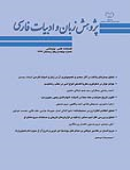تحلیل انتقادی انگارۀ زن در «سندبادنامه»
محورهای موضوعی : پژوهشهای ادبیات کلاسیک ایران
شیوا کمالی اصل
1
![]() ,
حبیب الله عباسی
2
,
عفت نقابی
3
,
حبیب الله عباسی
2
,
عفت نقابی
3
![]() ,
عصمت خوئینی
4
,
عصمت خوئینی
4
1 - زبان و ادبیات فارسی
2 -
3 - دانشیار زبان و ادبیات فارسی دانشگاه خوارزمی
4 - دانشگاه خوارزمی
کلید واژه: سندبادنامه زن قدرت عاملیت تحلیل گفتمان انتقادی فرکلاف,
چکیده مقاله :
ادبیات، آیینه ای است که فرهنگ جامعه را بازتاب می دهد و متون داستانی، بستر مناسبی برای بررسی این بازتاب های فرهنگی در زمینه های گوناگون از جمله مباحث مربوط به زنان است. در این پژوهش، برای واکاوی انگارۀ زن، دو حکایت از سندبادنامه انتخاب شد. متن سندبادنامه هر چند در یک زمینۀ تاریخی زنستیز تولید شده، نمونه های فراوانی از قدرت زن در آن دیده می شود. این جستار درصدد است تا با روش توصیفی- تحلیلی بر مبنای رویکرد تحلیل گفتمان انتقادی با تکیه بر نظریۀ «فرکلاف»، متن را در سه سطح توصیف، تفسیر و تبیین بررسی نموده، نشانه های قدرت زن و چرایی آن را نشان دهد. در این جستار به این نتیجه رسیدیم که زن در این اثر، حضور فعال و قدرتمند دارد و نقش فاعلی او در شکلگیری روند داستان مشهود است. در این کتاب به رغم دید منفی نسبت به زن، نشانه های قدرت پنهان زنانه را می توان دید. زنان برای رسیدن به اهداف خود از ابزار قدرت پنهان همچون زبان، تدبیر، زیرکی و سیاست استفاده می کنند و اگر راه های رسیدن به اهداف سازنده و والا برای آنها بسته شود، گاهی این قدرت در مسیر نادرست به کار گرفته می شود.
Literature is a mirror that reflects the culture, and fictional texts are an appropriate ground upon which these cultural reflections in a variety of fields, including issues related to female status could be examined. In this research, two anecdotes were selected from Sindbad-Nameh to analyze the female role. Although the text of Sinbad-Nameh has been produced in a historical misogynistic context, there are many examples of the female power in it. This paper, with a descriptive-analytical approach, studies the text based on Fairclough’s critical discourse analysis method, at three levels of description, interpretation and explanation, to analyze the mechanisms of the representations of the female power. As a result, it was concluded that the women in this work have an active and powerful presence and that their active role in shaping the anecdote process is evident. Also, despite the negative attitude towards women, the signs of their hidden power can be observed. In this work, Women use intangible means of power such as language, tact, intelligence and politics to achieve their goals and if the ways to gain the constructive and lofty goals are closed to them, that power is sometimes misused.
